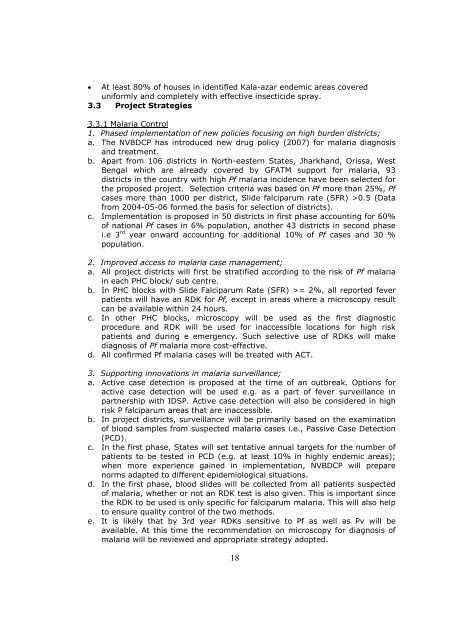National Project Implementation Plan - NVBDCP
National Project Implementation Plan - NVBDCP
National Project Implementation Plan - NVBDCP
Create successful ePaper yourself
Turn your PDF publications into a flip-book with our unique Google optimized e-Paper software.
At least 80% of houses in identified Kala-azar endemic areas covered<br />
uniformly and completely with effective insecticide spray.<br />
3.3 <strong>Project</strong> Strategies<br />
3.3.1 Malaria Control<br />
1. Phased implementation of new policies focusing on high burden districts;<br />
a. The <strong>NVBDCP</strong> has introduced new drug policy (2007) for malaria diagnosis<br />
and treatment.<br />
b. Apart from 106 districts in North-eastern States, Jharkhand, Orissa, West<br />
Bengal which are already covered by GFATM support for malaria, 93<br />
districts in the country with high Pf malaria incidence have been selected for<br />
the proposed project. Selection criteria was based on Pf more than 25%, Pf<br />
cases more than 1000 per district, Slide falciparum rate (SFR) >0.5 (Data<br />
from 2004-05-06 formed the basis for selection of districts).<br />
c. <strong>Implementation</strong> is proposed in 50 districts in first phase accounting for 60%<br />
of national Pf cases in 6% population, another 43 districts in second phase<br />
i.e 3 rd year onward accounting for additional 10% of Pf cases and 30 %<br />
population.<br />
2. Improved access to malaria case management;<br />
a. All project districts will first be stratified according to the risk of Pf malaria<br />
in each PHC block/ sub centre.<br />
b. In PHC blocks with Slide Falciparum Rate (SFR) >= 2%, all reported fever<br />
patients will have an RDK for Pf, except in areas where a microscopy result<br />
can be available within 24 hours.<br />
c. In other PHC blocks, microscopy will be used as the first diagnostic<br />
procedure and RDK will be used for inaccessible locations for high risk<br />
patients and during e emergency. Such selective use of RDKs will make<br />
diagnosis of Pf malaria more cost-effective.<br />
d. All confirmed Pf malaria cases will be treated with ACT.<br />
3. Supporting innovations in malaria surveillance;<br />
a. Active case detection is proposed at the time of an outbreak. Options for<br />
active case detection will be used e.g. as a part of fever surveillance in<br />
partnership with IDSP. Active case detection will also be considered in high<br />
risk P falciparum areas that are inaccessible.<br />
b. In project districts, surveillance will be primarily based on the examination<br />
of blood samples from suspected malaria cases i.e., Passive Case Detection<br />
(PCD).<br />
c. In the first phase, States will set tentative annual targets for the number of<br />
patients to be tested in PCD (e.g. at least 10% in highly endemic areas);<br />
when more experience gained in implementation, <strong>NVBDCP</strong> will prepare<br />
norms adapted to different epidemiological situations.<br />
d. In the first phase, blood slides will be collected from all patients suspected<br />
of malaria, whether or not an RDK test is also given. This is important since<br />
the RDK to be used is only specific for falciparum malaria. This will also help<br />
to ensure quality control of the two methods.<br />
e. It is likely that by 3rd year RDKs sensitive to Pf as well as Pv will be<br />
available. At this time the recommendation on microscopy for diagnosis of<br />
malaria will be reviewed and appropriate strategy adopted.<br />
18

















